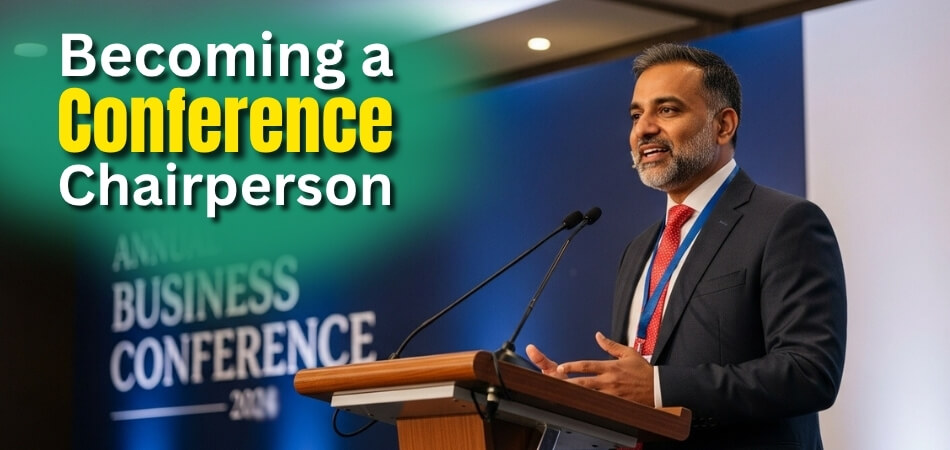Conferences are more than just gatherings; they are platforms for sharing ideas, inspiring conversations, and shaping industries. At the heart of every successful event stands the chairperson, guiding the flow and ensuring everything runs smoothly. Stepping into this role isn’t just about prestige; it’s about preparation, leadership, and genuine passion for the subject.
But, how to become a conference chairperson?
To become a conference chairperson, first build knowledge in your subject by studying and sharing your work. Then join conference groups or help plan sessions. Talk to organizers and show interest. If chosen, prepare by learning about the speakers and topics, and stay organized during the event.
Learn how to excel in this role with these practical steps and insider tips.
How to Become a Conference Chairperson: Step-by-Step Guide
Leading a conference takes skill, care, and a clear plan. This guide breaks the journey into simple steps anyone can follow. You will grow your expertise, build key ties, and learn to run the room. Use it to move from eager volunteer to trusted chair with calm, confident leadership skills.
Step 1: Clarify Your Role and Purpose
Begin with clarity about what a chair does. You guide flow, keep time, and support speakers. You protect the audience’s focus and energy. Note these duties, and decide why this role matters to you.
Step 2: Build Deep Subject Expertise
Study your topic each week. Read recent papers, take notes, and test ideas. Share small takeaways with peers to confirm your grasp. Strong knowledge gives you steady judgment onstage.
Step :3 Share Your Work Publicly
Publish short posts or slides on lessons you learn. Speak at meetups and panels when you can. Record demos and share them online with clear titles. These signals help organizers see your value.
Step 4: Join Committees and Volunteer
Offer help to program teams before you ask for the chair role. Volunteer to review abstracts or to greet speakers. Take on small tasks, finish them fast, and follow up. People trust steady action more than big promises.
Step 5: Network with Organizers and Speakers
Reach out to organizers with a brief, warm note. Mention your focus, your talks, and your fit. Ask how you can support the next event. Keep ties strong with speakers through kind, useful messages.
Step 6: Target the Right Events
Choose events that match your strengths and goals. Compare formats, audience size, and themes; scan listings of upcoming conferences in your field to find good fits. Mark deadlines and submission rules, then plan. A clear target list saves time and boosts results.
Step 7: Prepare for the Assignment
Prepare well once you get the nod. Learn about each speaker, their work, and their style. Draft a tight running order with times, intros, cues, and backups. Rehearse names, tricky terms, and your opening lines.
Step 8: Lead the Session on the Day
Lead the room with calm energy. Welcome the audience, set rules, and frame the goal. Keep time with gentle cues and crisp transitions. Solve hiccups fast while you support every speaker.
Step 9: Reflect and Grow Afterward
Review what went well after the event. Thank speakers, staff, and hosts with real notes. Save lessons and update your checklist. Then pick one new skill to strengthen before the next role.
What are the Responsibilities of a Conference Chairperson?
A conference chairperson carries key responsibilities that shape the quality of the entire event. Their role goes beyond formal duties, touching leadership, timing, and interaction with both speakers and attendees. Below, you’ll find the main reasons why this position matters and how its responsibilities unfold.
Guiding the Session Flow
- A chairperson begins sessions with a clear focus, setting a confident tone that makes every participant feel truly welcome.
- They manage time blocks with precision, creating space for talks, questions, and transitions without rushing any segment.
- Ending a session requires firm closure, giving thanks to participants while signaling the smooth transition to the next.
Introducing Speakers with Accuracy
- Each speaker’s profile must be shared with respect, often including concise details about their journey and expertise.
- A thoughtful introduction builds audience trust, allowing listeners to value both the speaker’s words and unique experience.
- Clear introductions also reduce confusion, ensuring the audience knows exactly what topics and insights are being presented.
Managing Time and Schedules
- Chairs monitor every presentation, making sure speakers stay within their agreed-upon times while keeping the flow consistent.
- They also balance Q&A moments, cutting off politely when time runs out while still encouraging audience curiosity.
- Time management avoids overlap, protecting the broader event structure from delays or missed opportunities in later sessions.
Facilitating Audience Engagement
- A chairperson opens discussions with inclusive questions, encouraging participation from diverse voices within the audience.
- They ensure debates remain respectful, guiding conversations toward insight rather than allowing distractions or irrelevant tangents.
- By fostering active dialogue, they help transform presentations into memorable exchanges that enhance collective learning and understanding.
Coordinating With Organizers
- Close work with event staff ensures smooth logistics, from microphones and lighting to seating arrangements and breaks.
- Chairs often assist with last-minute adjustments, solving issues without affecting the audience experience or speaker confidence.
- They provide feedback after sessions, helping organizers refine details for stronger execution at future gatherings and events.
How Can You Request Chairing Opportunities at Academic Conferences?
Opportunities can open up when you show real interest and take simple steps that people notice quickly. Many students and young researchers often want to do more than just listen to events. They want to learn how to help and guide small parts of the program. It takes some planning, some courage, and also a clear way to let others know your skills. Here’s how you can request.
Show Interest Early
Reaching out first can make a huge difference. You can write an email to the organizers or find a contact form on the website. Mention what subject you know well and why you want to help. A small step like this shows you are serious and prepared.
Take Small Roles
Helping out with small jobs builds trust. You might join a team that checks papers or plan a tiny session. Doing these things makes people see your hard work and responsibility. Over time, that trust can lead to bigger chances.
Join Associations
Membership in professional groups often helps a lot. These groups run events and invite people from inside the community. When you are active, you might get picked to lead a session. Being part of such groups gives you both contacts and chances.
Watch for Calls
Sometimes conferences post notices looking for chairs. These calls can appear on websites or even in newsletters. If you keep checking, you won’t miss them. Apply with your details, CV, and list of past activities to show your readiness.
Build Connections
Talking to senior teachers, experts, and past chairs can open many doors. They can suggest your name when roles come up. Even a kind word or a simple referral can help. These personal links are very powerful for future opportunities.
Show Past Work
If you have spoken at events, presented research, or managed small tasks, highlight that. Organizers look at past records before choosing. It proves you can handle the task well. This step makes you look dependable and steady.
Highlight Skills
Your request should include the skills you bring. You might say you are good at time control, or that you keep things moving smoothly. These skills are what a conference chairperson is expected to show. Being clear about them makes your request stronger.
Follow Process
Many conferences have formal rules for choosing chairs. They may ask for applications or set deadlines for requests. Some even want you to be a member first. Respecting the process shows your discipline and seriousness for the role.
Best Checklist to Prepare Before Chairing a Conference Session
Speaking at a big event can feel exciting, but leading the session brings even more responsibility. People look to you to guide, keep time, and make sure everything runs without stress. The best way to stay calm is to be well-prepared. A clear checklist helps you stay in control and ready for the task.
Know the Agenda
Before the event starts, read the full program carefully. Check the session topics, speaker names, and timing. When you know the plan, you can stay confident and handle surprises better. It makes you feel in charge of the moment.
Learn About Speakers
Spend some time reading about the speakers and their work. You can note small details for their introductions. Knowing who they are will help you sound natural and respectful. It also builds trust with both speakers and the audience.
Prepare Your Opening
Your first words set the mood for the whole session. Write a short welcome that is warm and simple. Include the session theme and remind people of the schedule. A clear opening helps everyone feel ready and focused.
Keep Time Handy
Carrying a watch, phone, or timer is very important. You need to remind speakers when their time is almost done. Gentle signals can keep things moving without pressure. Staying on time makes the whole event look professional and smooth.
Plan the Questions
Think about how you will guide the question round. Encourage short questions and fair chances for all. Step in politely if discussions get too long. Good control during Q&A makes the session more enjoyable for everyone.
Check the Setup
Arrive early to look at the microphone, slides, and seating. Small checks can save big problems later. If something doesn’t work, tell the staff quickly. Being aware of the setup makes you feel more relaxed.
Stay Calm and Ready
Sometimes things will not go as planned, and that’s normal. Stay calm, smile, and make small adjustments. People notice your confidence more than small mistakes. A calm chair keeps the session running without stress for anyone.
How to Handle Time Overruns and Difficult Presenters as Chair?
Managing speakers can sometimes be tricky when you are the chair of a session. Some presenters speak longer than expected. Others may not follow the agreed schedule or directions. Learn how to act to keep things balanced and professional.
- Set Clear Rules: Explain the time limits at the start so everyone knows. Reminding them early helps prevent confusion and unwanted overruns.
- Use Visual Signals: Hold up cards or give light hand signals when time is close. This way, speakers see reminders without interrupting the flow.
- Give Gentle Warnings: Politely remind a speaker when they cross time limits. A calm but firm tone keeps respect while holding control.
- Cut Questions Short: If a talk runs late, reduce the number of questions. This keeps the session moving without disappointing the audience entirely.
- Stay Polite Always: Treat presenters kindly, even if they test limits. Your patience builds trust and shows leadership while protecting the session’s balance.
- Step In Quickly: Interrupt firmly but politely when speakers ignore signals. Doing this early prevents further delays and keeps the schedule on track.
- Reframe the Talk: Summarize the speaker’s main points if they refuse to stop. This allows closure without wasting extra time or attention.
- Involve the Audience: Shift focus by inviting quick questions or remarks. This breaks the tension and signals clearly that the talk has ended.
- Stay Calm and Confident: Keep a steady voice even during conflict. Confidence reassures the audience while calmness reduces stress for both you and the speakers.
- Learn Each Time: After the session, think about what worked and what didn’t. These lessons will prepare you for future difficult situations.
Tips to Excel as a Conference Chairperson
Being a chair at a conference is more than standing on stage with a microphone. You guide speakers, manage time, and make sure the audience enjoys the session. Many people feel nervous at first, but practice helps a lot. With simple tips, you can build confidence and do really well.
Know the Program
Read the schedule carefully before the session starts. Learn about the speakers, their topics, and the time given to each. This helps you feel prepared and organized. When you know the plan, you won’t be surprised.
Start with Energy
Begin the session with a friendly welcome. Use simple words and set a positive tone that makes people comfortable. A warm start creates a good mood. It also helps the audience pay attention from the beginning.
Introduce Speakers Well
Give short introductions that highlight the speaker’s work. Avoid reading long notes and keep it natural. A good introduction shows respect and builds trust. It also makes the speaker feel valued and ready to talk.
Manage the Clock
Keep a close eye on the time during the session. Use small signals to remind speakers when they are close to ending. Staying on schedule keeps things smooth for everyone. It also shows you are in control.
Encourage Questions
Guide the audience when it’s time for questions. Ask for short and clear questions to save time. Help manage the flow by giving chances fairly. Good handling makes the discussion interesting and balanced.
Show Key Skills
Confidence and patience are important during your role. Clear speaking and time control are also vital skills needed to be a good conference chairperson. When you use these abilities, people notice your effort. These skills help you handle tough situations calmly.
Stay Calm Always
Unexpected issues may happen, like late speakers or technical problems. Stay calm and solve them without showing stress. A relaxed attitude makes people feel safe. The audience and speakers respect you more when you keep cool.
FAQs About Becoming a Conference Chairperson
Taking on the role of a conference chairperson can sound exciting yet challenging. Many people wonder what steps or qualities really make a difference. These FAQs give practical answers to questions you might still have in mind.
What Qualities Make a Good Chairperson?
A good chairperson needs confidence, patience, and clear communication. They must stay organized, keep track of time, and handle unexpected issues calmly. Strong leadership helps manage the session smoothly, while kindness ensures both speakers and audiences feel respected throughout.
How Early Should I Start Preparing?
Preparation should begin weeks before the event. Start by learning the schedule, reading about speakers, and practicing introductions. Early planning gives confidence, reduces stress, and ensures you are ready to handle both expected tasks and sudden challenges on stage.
Do I Need Prior Experience to Chair?
Prior experience helps, but it isn’t always required. Many organizers value enthusiasm, willingness to learn, and reliable commitment. Volunteering in smaller roles first can build trust and credibility. Over time, your involvement makes you a stronger candidate for chairing.
Can Students or Young Researchers Chair Sessions?
Yes, students and young researchers often get opportunities to chair smaller sessions. Active participation, volunteering, and building networks can lead to invitations. Showing professionalism, preparation, and subject knowledge demonstrates readiness, even if you don’t have years of experience.
How Do I Gain Confidence on Stage?
Confidence comes with practice. Start by speaking at small events, leading group discussions, or practicing introductions. Familiarity with the program and speakers reduces nerves. Remember, preparation and calm delivery matter more than perfection, so focus on steady communication and clarity.
What Should I Do If Technology Fails?
Stay calm and address the issue quickly. Let the audience know about the problem while contacting event staff. If possible, continue without slides or microphones. A confident chairperson keeps the session moving, ensuring the audience stays engaged despite challenges.
How Can I Make Sessions Interesting?
Keep sessions engaging by introducing speakers warmly and encouraging thoughtful audience questions. Add short transitions between talks to maintain energy. Use humor lightly if appropriate. Making people comfortable and involved creates an enjoyable environment where learning feels natural and smooth.
What Should I Avoid as a Chairperson?
Avoid speaking too much, letting sessions run late, or ignoring audience interest. Don’t interrupt speakers rudely or appear unprepared. Lack of planning can weaken your role. Respecting time, keeping order, and showing fairness make you trusted as a chairperson.
Closing Remarks
Being a chair in a conference can feel big, but it is not impossible. You guide speakers, watch the time, and keep the audience interested. Small actions, like planning early and staying calm, make a huge difference. When you think about how to become a conference chairperson, remember it is mostly about being prepared and kind.
Each session gives you more practice and helps you get better. Learn from mistakes, thank people for their support, and keep improving. With steady effort and simple skills, you can lead sessions with confidence and make the event enjoyable for everyone.








